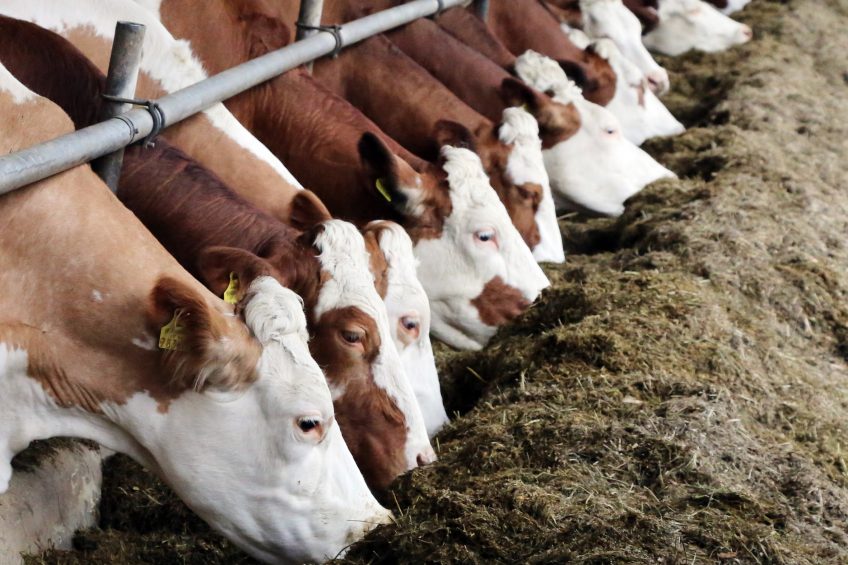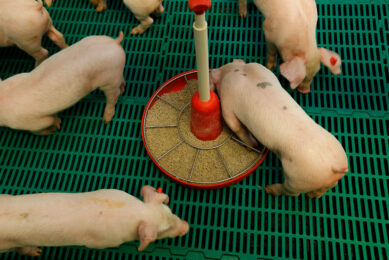Dairy management: It’s all in the feed

In dairy farms, efficiency of nutrient use is generally considered to be a crucial factor impinging farm profitability. As such, feed efficiency and cost management now represent major tools in modern production.
Besides general aspects, such as the animal’s age, genetics, reproduction status or external environmental factors, there are also several aspects of feed management, which show an impact on feed efficiency. In ruminants, feed efficiency is linked to energy metabolism via two main factors; digestive efficiency and metabolic efficiency.
Optimising digestibility – Digestive efficiency in the rumen strongly depends on neutral detergent fibre digestibility (NDFd), which mainly correlates to forage quality. Sauvant et al. have shown, that an increase of the dry matter intake by already 1% (related to body weight) reduces the organic matter digestibility, because a higher turnover shortens the passage time in the gastrointestinal tract. Fibre digestibility also correlates negatively with every 10% increase of concentrate in the diet, because of a lowered pH value. Furthermore, bacteria need degradable protein to digest fibre, thus an under supply of protein further reduces organic matter digestibility.
In fact, these interactions between organic matter digestibility and fibre digestibility may represent between 0 and 28 MJ of net energy losses per day (until an equivalent of 9 litres of milk per day). An increased digestion of feed in the gastrointestinal tract of livestock animals due to a higher turnover rate of specific digestive enzymes can boost the efficiency in conversion of feed or nutrients. This enhanced digestibility of feed or nutrients can mainly be obtained via two different paths: by breeding animals with a better digestibility performance, or by specific plant breeding programmes to increase the nutritive value of feed plants. Additionally, phytogenic feed additives (see box) are potent to improve fibre degradability in the rumen by fibre bacteria stimulation. They also have the power to stimulate the enzyme production in the small intestine.
Optimising metabolic activity – Energy efficiency strongly depends on methane and ammonia production in the rumen. During fermentation, some energy is lost via methane production from CO2 and H2. These losses vary between 4 and 10% of the gross feed energy and rise with increasing fibre digestibility. It’s known that the type of feed has a huge influence on the methane production level: Methane production is reduced by the high level of degradable starch, a low level of fibre, a high level of polyunsaturated fatty acids (PUFA), a high level of medium chain fatty acids (MCFA) or a high level of concentrate in the diet. A further reduction of noxious gas emissions can be obtained by adding phytogenic feed additives acting against methanogenes and against protozoa, both of them supporting methane production. Few studies show the impact of the genotype on methane fermentation in the digestive tract of ruminants. Improving animal health with best management and best feeding will help to reduce losses during production. For example, the milk production decreases with an increasing level of somatic cell counts in milk. Also due to acidosis, energy will be lost in the rumen in combination with a milk fat and a milk production drop.
Figure 1 – Overview of protein losses in milk production of dairy cows.

Protein balance between rumen and small intestine
In dairy cows a poor level of protein in diets may result in poor feed efficiency. The protein efficiency is expressed as the ratio of milk protein production (kg/day) related to protein intake (kg/day) and, in general, is very low in dairy cows. A cow, producing 30 litres of milk per day (3.3% crude protein), requires an amount of 3.5 kg dietary protein (Figure 1). This means that only less than 30% of the dietary protein are used for the production of milk protein. The losses run up to more than 70%, resulting from urea content in the urine due to ammonia excess in rumen; indigestible and endogenous excretion in faeces and urine, and excretion via urine due to an inefficient utilisation of absorbed protein for maintenance and for the synthesis of milk and body protein. Another good indicator is the level of MUN (Milk urea Nitrogen in mg/L or dL of milk): more MUN means less protein efficiency (Figure 2).
Figure 2 – N-efficiency depending on feed quality (after Cyriac et al., 2008).

In the rumen, NH3 is produced via deamination of amino acids or non-protein compounds (e.g. urea and amides). NH3 may be used for microbial growth, provided that energy is available. It may also escape at the lower gastrointestinal tract or be absorbed through the rumen wall and transferred to the blood and liver, where ammonia is transformed to urea. This is either transferred back to the rumen through saliva and the rumen wall, or it is excreted in the urine.
A lack of ruminal degradable protein will negatively affect the production of microbial protein and, thus, will depress fibre digestibility. In this case feed intake is reduced due to a lowered passage rate and, consequently, a lower ruminal production of volatile fatty acids (especially acetate) reduces milk fat production. On the contrary, excessive degradable protein supply may cause increased protein losses and may affect health and fertility. The costs for the cow are 7.3 kcal of metabolised energy for each gram of ammonia that is converted to urea in the liver. The urea content in milk represents an important tool for monitoring the cow’s nutritional condition. As ‘waste’ of the protein metabolism, it enables conclusions to be drawn regarding the protein and energy supply of the animal.
Improved ruminal fermentation
To optimise protein efficiency, the rumen needs to be provided with a certain amount of protein, respectively nitrogen sources on the one hand, and sufficient energy (with a good balance between fermentable organic matter and structural carbohydrates) on the other. A sufficient supply with minerals and vitamins and best water quality also contribute to improved ruminal fermentation. Besides this, ruminal microflora can be directly influenced and optimised by several feed additives, such as phytogenics.
In the small intestine, a part of the protein escapes from degradation in the rumen. In this case the digestibility of the so-called bypass protein will be linked with raw materials between 50 and 95%. Thus, high quality raw materials show a good digestibility with regard to the bypass protein fraction. For example, in soybean meal 90% of the metabolised protein derive from bypass protein compared to 56% of metabolised protein resulting from rumen degradable protein.
Challenges regarding profitable dairy production emphasise the importance of nutritional expertise and optimum feeding management, allowing livestock to fully meet their genetic potential. Concentrating on feed efficiency in dairy cows is very important to optimise the exploitation of dry matter intake, hence, to achieve better margins in milk production over the long-term.
Benefits of phytogenic feed additives
High quality phytogenic products, as produced by Delacon, containing essential oils and herbs and spices, supplemented to animal rations, have shown to support feed efficiency in a natural, though proven way. They do not only contribute to optimal performance and profitability, but are also the best choice for the reduction of emissions in animal husbandry. Therefore, and due to their high acceptance by consumers, they are foreseen to have a great future in livestock nutrition whilst contributing to safe animal derived products. Phytogenic feed additives are powerful in improving microbial protein efficiency. They can help binding and protecting bypass protein and thus improving protein and feed efficiency. For cows, they have shown to be potent in reducing starch degradation in the rumen lowering the risk of acidosis.






